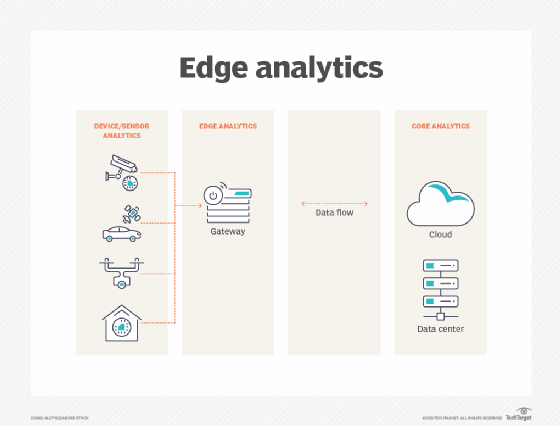edge analytics
What is edge analytics?
Edge analytics is an approach to data collection and analysis in which an automated analytical computation is performed on data at a sensor, network switch or other device instead of waiting for the data to be sent back to a centralized data store.
Edge analytics has gained attention as the internet of things (IoT) model of connected devices has become more prevalent. In many organizations, streaming data from manufacturing systems, industrial equipment, pipelines and other remote devices connected to the IoT creates a massive glut of operational data, which can be difficult -- and expensive -- to manage. By running the data through an analytics algorithm as it's created -- at the edge of a corporate network -- companies can set parameters on what information is or isn't worth sending to a cloud or on-premises data store for later use.
Analyzing data as it's generated can also decrease latency in the decision-making process on connected devices. For example, if the sensor from a manufacturing system detects the likely failure of a specific part, business rules built into the analytics algorithm interpreting the data at the network edge can automatically shut down the machine and send an alert to plant managers so that the part can be replaced. This can save time compared with transmitting the data to a central location for processing and analysis, potentially letting organizations reduce or avoid unplanned equipment downtime.
Real-time analysis of data facilitates real-time decision-making. An example of this kind of immediate turnaround includes rerouting workloads to machines in a factory when issues in a particular machine, detected by IoT edge devices, predict that the performance of that machine will degrade.
Another primary benefit of edge analytics is scalability. Pushing analytics algorithms to sensors and network devices alleviates the processing strain on enterprise data management and analytics systems even as the number of connected devices being deployed by organizations -- and the amount of data being generated and collected -- increases.
How is edge analytics used?
One of the most common use cases for edge analytics is monitoring edge devices. This is particularly true for IoT devices. A data analytics platform might be deployed for monitoring a large collection of devices and ensuring the devices are functioning normally. If a problem does occur, an edge analytics platform might be able to take corrective action automatically. If automatic remediation isn't possible, then the platform could instead provide the IT staff with actionable insights to help them fix the problem.
A prominent example of edge analytics in action is the management of vehicle fleets, such as small, automated lifts and trucks on a loading dock or factory floor. Sensors and other IoT devices in the vehicle, along with similar IoT devices placed throughout a warehouse, result in an integrated network that can coordinate activities among the vehicles to achieve optimal performance and efficiency of the entire fleet in real time. In addition, organizations can use the performance data from routine operations to improve the efficiency of warehouse design and operations over time.
Benefits of edge analytics
Edge analytics delivers the following compelling benefits:
- Near real-time analysis of data. Because analysis is performed near the data -- often on board the device itself -- the data can be analyzed in near real time. However, this wouldn't be the case if the device had to transmit the data to a back-end server in the cloud or to a remote data center for processing.
- Scalability. Edge analytics is by its nature scalable. Because each device analyzes its own data, the computational workload is distributed across devices.
- Possible reduction of costs. Significant costs are associated with traditional big data analytics. Regardless of whether the data is processed in a public cloud or in an organization's own data center, there are costs tied to data storage, data processing and bandwidth consumption. Some of the edge analytics platforms for IoT devices use the IoT device's hardware to perform the data analytics, thereby eliminating the need for back-end processing.
- Improved security. If data is analyzed on board the device that created it, then it's not necessary to transmit the full data set across the wire. This can help improve security because the raw data never leaves the device that created it.

Limitations of edge analytics
Like any other technology, edge analytics has its limits. Those limitations include the following:
- Lack of hardware support. Simply put, not every IoT device has the memory, processing and storage hardware required to perform deep analytics on board the device.
- Lack of edge analytics platforms. Edge analytics is still a relatively new technology. Although off-the-shelf analytics platforms do exist, it's entirely possible that an organization might have to develop its own edge analytics platform based on the devices that it wants to analyze.
Applications of edge analytics
Edge analytics tends to be most useful in industrial environments that use many IoT sensors. In such environments, edge analytics can deliver benefits such as the following:
- Improved uptime. If an edge analytics platform can monitor a sensor array, it might be able to take corrective action when problems occur. Even if the resolution isn't automated, simply alerting an operator to a problem can help improve the overall uptime.
- Lower maintenance costs. By performing in-depth analysis of IoT devices, it might be possible to gain deeper insight into device health and longevity. Depending on the environment, this could help the organization reduce its maintenance costs by performing maintenance when it's necessary rather than following a general maintenance schedule.
- Predict failures. An in-depth analysis of IoT hardware makes it possible to accurately predict hardware failures in advance. Organizations could take proactive steps to head off a failure.
Edge analytics vs. edge computing
Edge computing is based on the idea that data can be collected and processed near the location where it's either being created or consumed. Edge analytics uses these same devices and the data that they've already produced. An analytics model performs a deeper analysis of the data than what was initially performed, creating actionable insights.
Cloud analytics vs. edge analytics
Both cloud analytics and edge analytics are techniques for gathering relevant data and then using that data to perform data analysis. The key difference between the two is that cloud analytics requires raw data to be transmitted to the cloud for analysis.
Although cloud analytics has its place, edge analytics offers the following advantages:
- Edge analytics incurs far lower latency than cloud analytics because data is analyzed on site -- often within the device itself, in real time, as the data is created.
- Edge analytics doesn't require network connectivity to the cloud. This means that it can be used in bandwidth-constrained environments or in locations where cloud connectivity isn't available.
Learn how the right data and analytics can be used to create a data-driven supply chain to help leaders manage customer demand and delivery issues.






